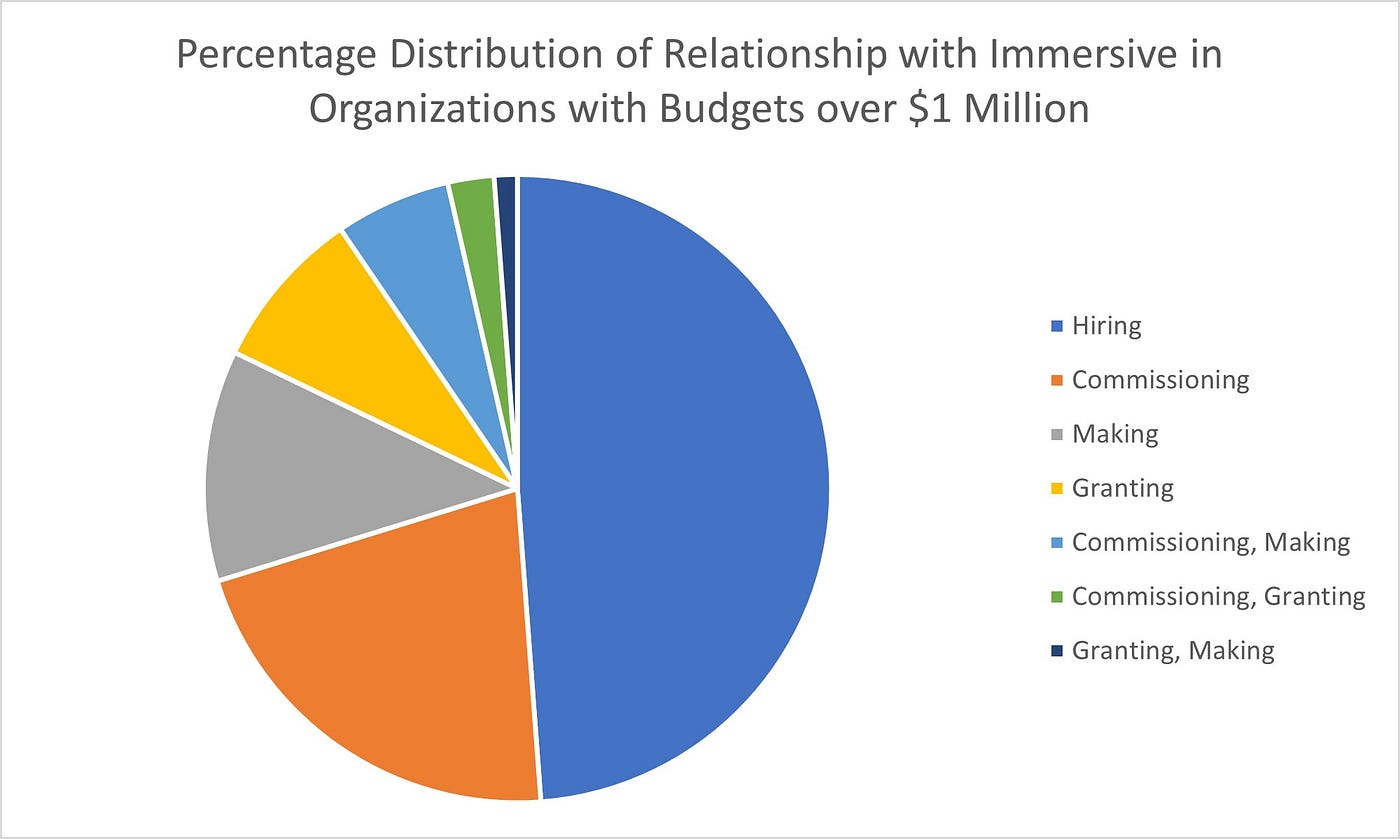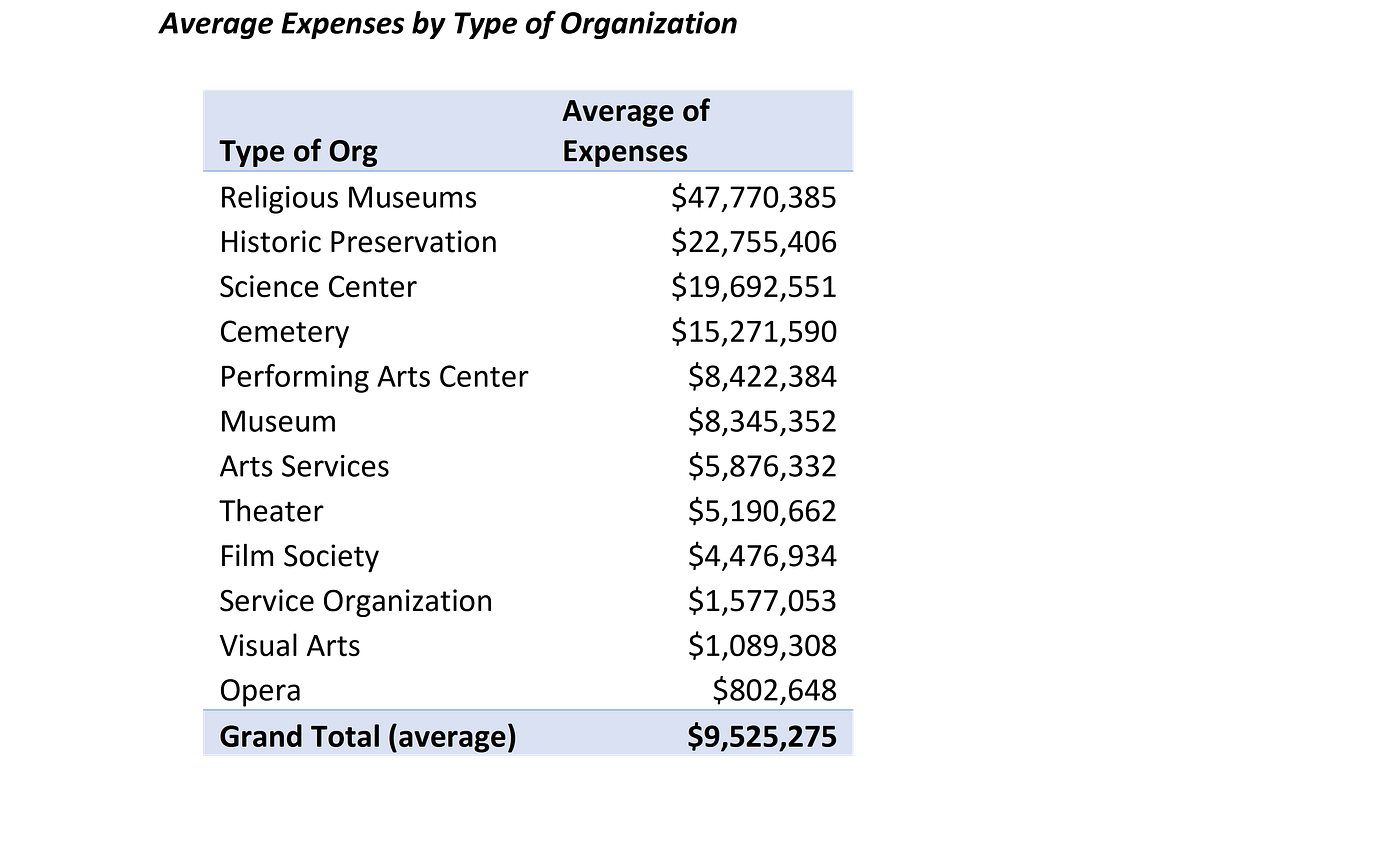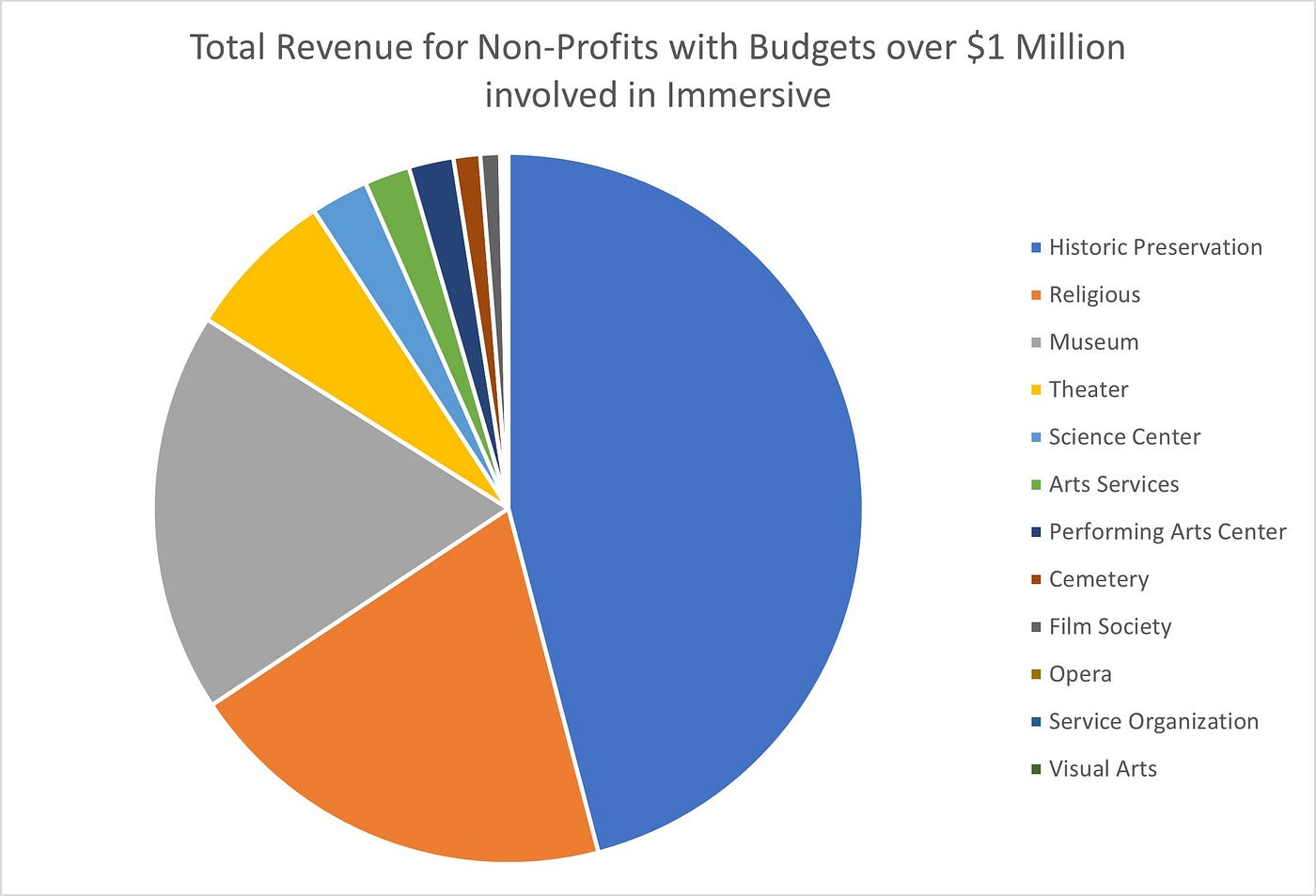The Road To The 2024 Immersive Industry Report Starts Here
The Immersive Experience Institute’s research cycle begins with a look at non-profits involved in immersive art & entertainment
Editor’s Note: This early look at the prep work behind the planned 2024 Immersive Industry Report has been assembled by Megg Mullarkey, Research Associate of The Immersive Experience Institute. This first look seeks to outline the silhouette of the non-profit side of the immersive field inside the United States. Future research will include international and for-profit commercial efforts as we seek to assemble a total picture of the field.
Non-Profit Organizations with Revenue or Expenses over One Million involved in Immersive Entertainment
In preparation for the publication of the 2024 Immersive Entertainment Industry report, The Immersive Experience Institute would like to share some preliminary findings as we expand our research scope. Specifically, we have been gathering data on 501(c)3 non-profit organizations in the U.S. engaged in producing immersive experiences as available in public-facing materials such as GuideStar, press releases, news articles, and organization websites.
As ever, the eventual goal of the industry report is to identify and analyze successful business models and trends in the immersive entertainment sector. Our line of inquiry based on non-profit institutions was to identify the kinds of institutions working with or on immersive entertainments and to classify their relationship with such work. To understand each organization’s relationship with the production of immersive entertainment, it was necessary to begin to stratify these organizations by newly proposed categories: hiring, making, commissioning, or granting.
Organizational Relationships with Immersive Categories and their definitions
The “Hiring” category includes organizations who employ immersive artists, collectives, companies, or consultation services to create work based on a brief developed by the organization. For example, a theatre company wants to put on an immersive Shakespeare show as part of their season and so hires an artist to develop it for them/with part of their team. Alternatively, Museums and Living History organizations who work with and hire immersive artists to create their exhibitions and programs also fit into this category.
Model Organization: Colonial Williamsburg
The “Commissioning” category includes organizations who solicit artists’ own work. i.e., a theater may put out a call for projects featuring immersive techniques and may produce several in a festival, or an organization may bring in immersive artists as residents for a season.
Model Organization: Denver Center for the Performing Arts, Off-Center
The “Granting” category includes organizations who give funds to individuals or collectives to make their own work through an application and review process. The artist may or may not be obligated to produce a showcase or draft work. This category also includes fiscal sponsorship.
Model Organization: FracturedAtlas
The “Making” category includes organizations involved in creating the immersive work themselves. The company, individual or collective works to create and produce immersive elements themselves with their own funding.
Model Organization: Bricolage Production Company
Researcher’s Note on Proposed Categories:
Our identification of organizations is preliminary, based on publicly available sources for each organization, including press, social media, web descriptions, etc. However, most valuable to a further study would be to have the organizations themselves self-identify their relationship category with immersive productions. Reaching out to organizations for self-identification along these categories will be part of the Industry Report’s next maker survey.
Data and Methods:
Data was collected by a combination of a radar sweep, documenting all organizations with revenue or expenses over one million dollars who explicitly mentioned immersive or immersion in their “about” pages or mission statements, or had a recent immersive project evidently displayed on their publicly facing materials. This list was then compared to and expanded by the pre-existing database at Everything Immersive, a publication of the Institute, of over one thousand organizations and businesses featured at some point in the past three years on that website.
Fiscal data was taken from the most recent IRS Form 990 documents uploaded to GuideStar, the premiere non-profit navigation database for researchers and funders. This study only includes 501(c)3 non-profit organizations in the United States, leaving international organizations as an avenue for further research. University training programs (theatre and other) were also not included in this study, as disambiguating their budgets between training and production is outside our current scope but is of future interest.
Preliminary Results and interpretations:
Considering our newly proposed categories of relationship with immersive entertainment (commissioning, hiring, granting, making), several notable trends are evident from this survey of non-profit organizations with budgets over one million, especially when compared with our preliminary research of small non-profit organizations with budgets under a million. At the one-million-dollar budget point and above, organizations usually have commissioning or hiring relationships with immersive entertainment — they are using immersive artists and installations to serve their organizations and often hiring and commissioning outside artists, consultant firms, or other arts organizations, rather than making the immersive experiences themselves. In preliminary comparisons with our in-progress study of organizations under $1 million budget point, however, one finds far more active makers in smaller-budget organizations.

Looking then at summaries of net gains or losses, it is clear that organizations under the hiring classification have significantly increased net gains as opposed to the other categories: making, commissioning, granting or sundry combinations of the four (as several organizations were involved in immersive production in more than one way).

In addition to stratifying the organizations by their relationship with immersive (hiring, making, commissioning, granting), we also sorted organizations by type based on their top affiliated GuideStar subject area. Some types on this list only had one member organization, such as Cemetery (Green Wood Cemetery), Visual Arts (Magic Gardens in Philadelphia) and Opera (Opera Parallèle). The complete list of types used for analysis in this list were: Religious, Historic Preservation (i.e., sites of “living history” such as Colonial Williamsburg, Jamestown), Science Center, Cemetery, Museum, Performing Arts Center, Arts Services, Theater, Film Society, Service Organization, Visual Arts, and Opera.
Overwhelmingly, and perhaps not surprisingly, the institutions involved with immersive entertainment with the largest net gain in their most recently available fiscal data on GuideStar were museums, both historical and religious, and historic preservation, with religious-based museums (Museum of the Bible and Answers in Genesis, Inc., owners of Kentucky’s “Ark Encounter”) ranking #2 and #4 respectively on top net gains amongst the organizations on this list.
The table below displays average expenses by type of organizations, with Religious, Historic Preservation and Science organizations having the largest operating budgets on average, with the two religious museum organizations mentioned above accounting for more than nine times the average amount of expenses of the theater type non-profit organizations on this list. When all types of organizations are taken together, the average expenses for non-profit organizations on this list is $9,525,275.

Looking at overall net gain and loss within non-profits with budgets over one million dollars, we find a similar trend, with Historic Preservation, Religious and Museum types creating over three quarters of the total $173,696,449 in revenue.

Additionally, as we continue our preliminary comparison with our study of non-profit organizations with budgets under one million dollars it is clear that FracturedAtlas, a non-profit organization on the over one million list is by far the most prolific fiscal sponsor of small non-profit organizations producing immersive experiences on the under one million list.
Known Unknowns, Suggestions for Further Research:
For clarity of comparison, university and education programs focusing on immersive entertainment and technology were not included on this list, although their budgets would have qualified them. Because of the funding structure of higher education, this would be a project requiring more detailed study of individual departments and projects and may not reflect trends in the public sector as accurately. However, research on university departments and projects focusing on immersive is a topic begging for further research.
International non-profit organizations involved with immersive entertainment were not included in this list and account for a large number of active members of the Everything Immersive database, and so should be a topic for further discussion and study.
Continued research and stratification with non-profit organizations in the US with budgets under one million is currently underway.
As always, we would recommend focusing on providing an impetus for organizations such as those examined in this summary to self-identify and partner with The Immersive Experience Institute to provide the most up-to-date data on their programming and budget models in order to benefit the industry at large.
Discover the latest immersive events, festivals, workshops, and more at our new site EVERYTHING IMMERSIVE, new home of NoPro’s show listings.
NoPro is a labor of love made possible by our generous Patreon backers. Join them today!
In addition to the No Proscenium website, our podcast, and our newsletters, you can find NoPro on Facebook, LinkedIn,YouTube, Twitter, Instagram, in the Facebook community Everything Immersive, and on our Patreon Backer exclusive Discord.